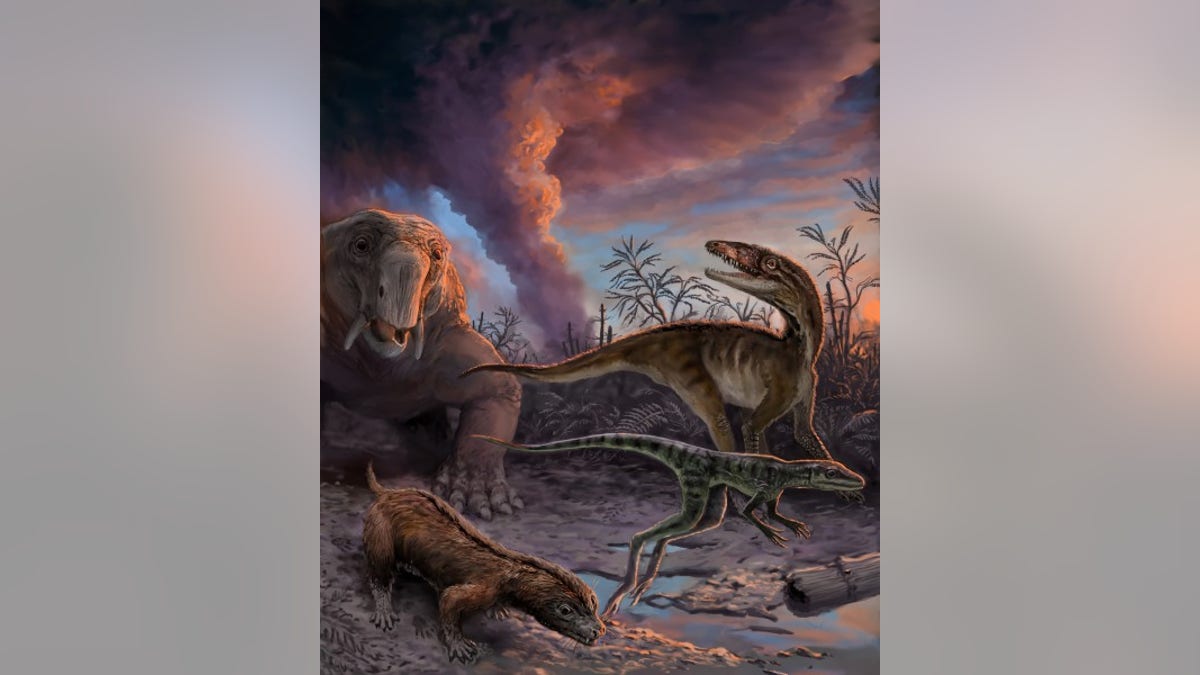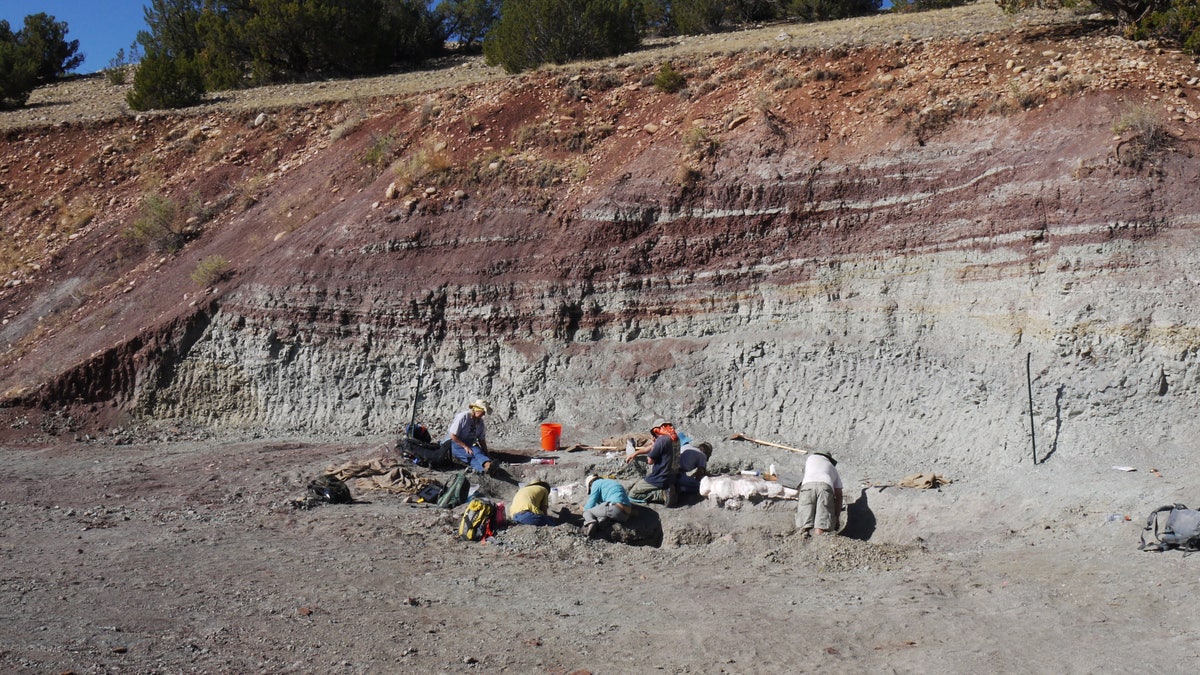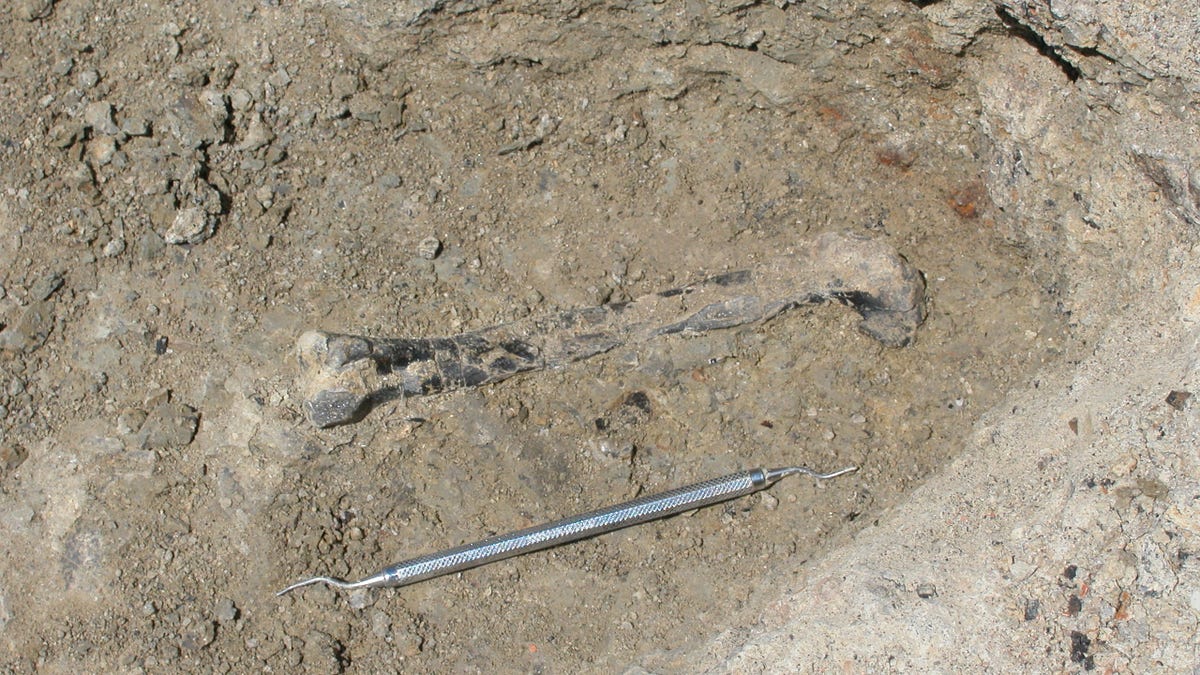
Animals escaping from an erupting volcano 235 million years ago in northwestern Argentina. These species, found as fossils in the Chañares Formation, include early mammal relatives (the dicynodont Dinodontosaurus in the left background, and the cynodont Massetognathus in the left foreground) and early dinosaur precursors (Lewisuchus in the right background, and Lagerpeton in the right foreground). By measuring radioactive isotopes in zircons crystals from the volcanic ash, scientists were able to determine the precise age of this fossil assemblage. (Victor Leshyk)
Because of the checkered fossil record, the exact origin and rise of dinosaurs has long been shrouded in uncertainty.
Among the biggest mysteries is just when the earliest relatives of dinosaurs known as dinosauromorphs emerged. Various hypotheses have suggested that dinosauromorphs appeared anywhere from just at the end-Permian extinction about 252 million years ago to closer to the arrival of the first dinosaurs around 231 million years ago.
Related: Newly discovered dinosaur flaunts its feathers
Now, a new study from the Proceedings of the National Academy of Sciences goes the furthest yet in detailing their arrival. It suggests that dinosauromorphs – a lineage that gave rise to dinosaurs and are known to look like them but with more primitive skeletons – emerged around 234 million to 236 million years ago or much closer to time when dinosaurs originated.
That would suggest that dinosaurs evolved much quicker than earlier thought and that their emergence didn’t change ecosystems as much as once believed.
“What was unexpected was that these earliest dinosauromorphs were so late in time. We thought that they were part of this ecological recovery that occurred soon after end-Permian mass extinction,” Randall Irmis, a co-author on the study and an associate professor and curator of paleontology at the Natural History Museum of Utah, told FoxNews.com.
Related: These dinosaurs liked to get their feet wet

Crews excavating vertebrate fossils from the Hayden Quarry at Ghost Ranch, NM. These rocks contain abundant fossils of pollen, charcoal, fish, and reptiles, all of which were used to reconstruct the ecosystem and environment of this area 212 million years ago. (Randall Irmis)
“For so long, people have been asking why did dinosaurs become so successful and what was special about them,” he said. “This shows that dinosaurs were just a part of a bigger radiation of dinosauromorphs and we should be really asking the question why dinosaurmorphs became so successful.”
The international team, which also included researchers from Brazil, Argentina and California, employed radioactive isotope measurements to date zircon crystals found in the sediments of the Chañares Formation in Argentina. It is famous for its fossils of early dinosaur relatives and thus an ideal place to study the relationship between early dinosaurs and dinosaurs.
“Among Triassic geologic formations containing fossils, the Chañares Formation is a classic. It contains a variety of complete fossil specimens of early dinosauromorphs, which are essentially dinosaur aunts, uncles and cousins,” Irmis said of the area that features an approximately 250-foot geologic formation comprised of sediments deposited by rivers, streams and lakes during the Triassic Period.
Related: New duck-billed dinosaur uncovered in Alaska, researchers say
Claudia A. Marsicano, the lead author on the paper from the University of Buenos Aires, agreed that the area - that looks a little like southern Utah, with its sweeping views of high desert badlands - offers paleontologists a unique look back in time.
“In other basins, dinosaur precursors, early dinosaurs and faunas dominated by dinosaurs do not all conveniently exist in the same place. In the basin containing the Chañares Formation, you can follow hundreds of meters of sediments back through time,” she said in a statement. “Because of this, the margin of error is very narrow because you can see the complete history all in one basin.”
Beyond the emergence of the dinosauromorphs, the findings also may call into question the timing of formations around the world that also have fossils of these dinosaur relatives from the Middle Triassic Period. Among them are the Santa Maria Formation in southern Brazil as well as the Karoo sequence in South Africa and the Omingonde Formation of Namibia.
Related: Pig-snouted turtle from dinosaur era discovered in Utah

This 212 million-year-old leg bone of an early carnivorous dinosaur is encased in rock prior to excavation at the Hayden Quarry, Ghost Ranch, New Mexico. Dinosaurs such as these were still small and uncommon components of their ecosystems in the low latitudes during the Late Triassic Period. (Randall Irmis)
“These formations were thought to preserve ecosystems that were recovering from this mass extinction event,” Irmis said. “If they are actually later in the time like the Chañares Formation, then it tells us they have very little to do with this recovery.”
To identify the dates of these dinosaur relatives, the team collected two rock samples from the Chañares Formation: One from the base of the level where fossils were preserved and one from near the formation’s top.
“The Chañares Formation contains tuffs, or volcanic ashes, that can be dated with great accuracy,” Irmis said. “So in this basin, not only are there many high-quality, complete fossils that allow us to easily identify taxa, but there are also tuffs in between that allow us to date the entire column.”
The rock samples contain volcanic ash that erupted at the same time as the sediments. The researchers crushed the samples to extract the zircon crystals that formed during the Triassic Period. From there, they were able to date when the crystals were formed by measuring the uranium/lead ratio in each crystal. This is one of the only measuring techniques that goes this far back in time.
“In a coarse way, you can place fossils in certain time periods, but if you wish to constrain a major evolutionary event, like the beginning of a group or the diversification of a group, the methodology has to have a margin of error that is much smaller,” Marsicano said. “For something that happens over the course of, say, 600 million years, an error of 3-4 million years is not statistically significant. But if something happens over the course of 10-12 million years, like the diversification of a group, an error of 3-4 million years is a major problem.”
Paul Olsen, Arthur D. Storke Memorial Professor at Columbia University, said the study showed how technology is improving dating that for the past two centuries often depended on the fossil record and more recently radiometric dating.
Olsen did not take part in the study but was responsible for deciding whether the paper should be published based on reviews from other scientists
“The techniques of uranium-lead dating have gotten so good that we can now very precisely determine the age in years of particular fossil deposits,” he said.
“It’s a completely independent way of judging time than using the fossils themselves,” Olsen added. “What’s happening right now is that this technique is changing the way we view so much of the early history of dinosaurs. For the first time, it’s telling us that there is a lot of complexity to the world of the early dinosaurs that was hidden by using the animals themselves to tell time.”
